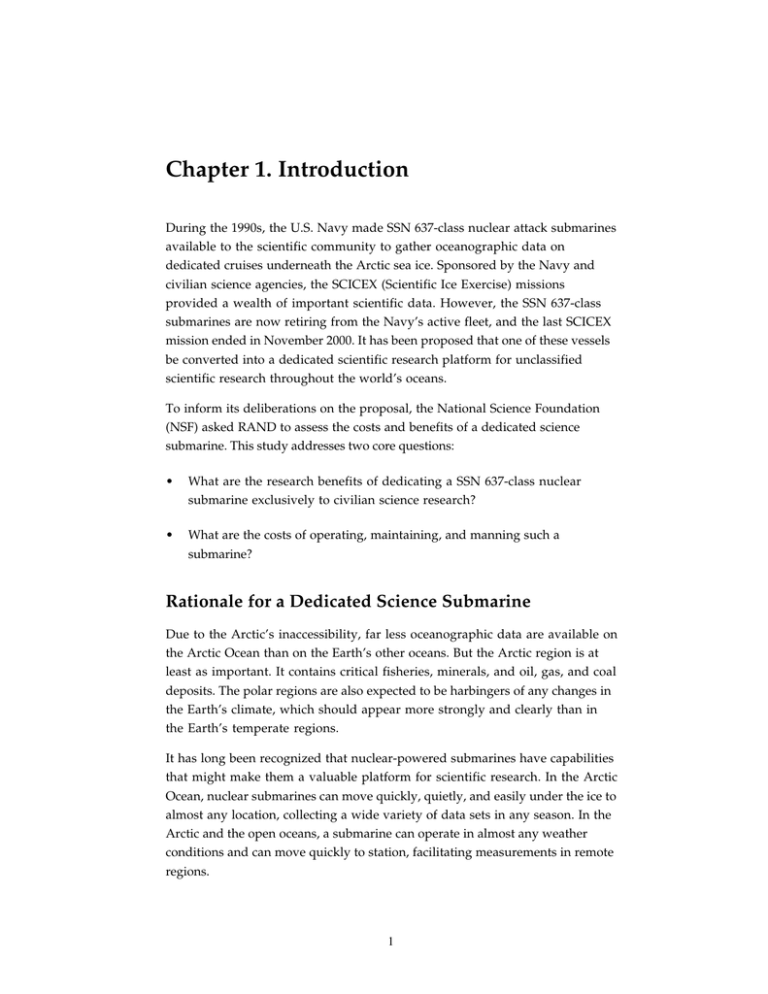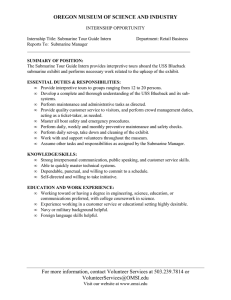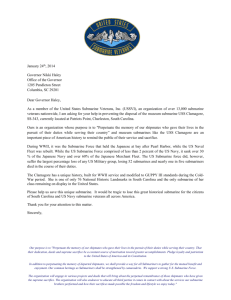Chapter 1. Introduction
advertisement

Chapter 1. Introduction During the 1990s, the U.S. Navy made SSN 637-class nuclear attack submarines available to the scientific community to gather oceanographic data on dedicated cruises underneath the Arctic sea ice. Sponsored by the Navy and civilian science agencies, the SCICEX (Scientific Ice Exercise) missions provided a wealth of important scientific data. However, the SSN 637-class submarines are now retiring from the Navy’s active fleet, and the last SCICEX mission ended in November 2000. It has been proposed that one of these vessels be converted into a dedicated scientific research platform for unclassified scientific research throughout the world’s oceans. To inform its deliberations on the proposal, the National Science Foundation (NSF) asked RAND to assess the costs and benefits of a dedicated science submarine. This study addresses two core questions: • What are the research benefits of dedicating a SSN 637-class nuclear submarine exclusively to civilian science research? • What are the costs of operating, maintaining, and manning such a submarine? Rationale for a Dedicated Science Submarine Due to the Arctic’s inaccessibility, far less oceanographic data are available on the Arctic Ocean than on the Earth’s other oceans. But the Arctic region is at least as important. It contains critical fisheries, minerals, and oil, gas, and coal deposits. The polar regions are also expected to be harbingers of any changes in the Earth’s climate, which should appear more strongly and clearly than in the Earth’s temperate regions. It has long been recognized that nuclear-powered submarines have capabilities that might make them a valuable platform for scientific research. In the Arctic Ocean, nuclear submarines can move quickly, quietly, and easily under the ice to almost any location, collecting a wide variety of data sets in any season. In the Arctic and the open oceans, a submarine can operate in almost any weather conditions and can move quickly to station, facilitating measurements in remote regions. 1 The Navy has a long, successful history of research from nuclear submarines in the Arctic that has demonstrated the feasibility of submarine-based research and the novel qualities of submarine datasets. The six SCICEX cruises conducted from 1993–1999 used Navy submarines with only minor modifications, with civilian scientists on board for scientific missions of several weeks’ duration. These cruises collected a broad range of data on the bathymetry, hydrography, ocean chemistry, and ice thickness throughout the Arctic Basin. These data contributed to a variety of important sciences. For instance, it contributed to the recent observation that the Arctic ice cover has thinned significantly over the last several decades.1 This potential has been recognized in a variety of official studies. The 1996 UNOLS report A Nuclear-Powered Submarine Dedicated to Earth, Ocean, and Atmospheric Research,2 found that the principal advantage of using a nuclearpowered submarine for research involved: • “Working under the ice in high latitudes, where a submarine can move more quickly and, if the water is deep enough, more easily than a surface research ship on the open ocean.” • “Working in very bad weather, where a surface ship cannot operate efficiently, or at all.” In a National Research Council report, a scientific panel considered the need for a new icebreaker dedicated to scientific research in the Arctic. As part of its analysis, the panel compared the research capabilities for the proposed icebreaker against a nuclear-powered submarine, as demonstrated by the initial SCICEX cruises. They concluded: The ability of a submarine to cruise beneath the ice at high speed independent of surface weather or ice conditions makes possible scientific investigations that require large amounts of under-ice areal coverage. In fact, submarine based capabilities are strongly preferred for most tasks comprising the proposed marine geology and geophysics research in the Arctic and would also be useful for other studies.3 ______________ 1 Rothrock, D.A., Y. Yu, & G.A. Maykut, 1999. “Thinning of the arctic sea-ice cover,” Geophys. Res. Lett., 26(23), 3469–72. 2 In this context, atmospheric research involves measurements of ocean processes and properties that influence the state of the atmosphere. 3 Arctic Ocean Research and Supporting Facilities: National Needs and Goals, National Research Council, National Academy Press, Washington D.C., 83 pages, 1995; p. 71. 2 Examining the Benefits and Costs With the ending of the SCICEX program, the Navy and NSF must decide whether and how to support a dedicated science submarine. In order to inform such a choice, decisionmakers need a systematic assessment of the benefits and costs of a dedicated science submarine. The submarine’s potential contribution must be weighed against a backdrop of existing, broad-ranging strategies for scientific research on the Arctic region (e.g., other data collection efforts, laboratory measurements, and modeling). In this study, we examine the benefits and costs of such a dedicated science submarine. As a concrete example, we consider the conversion of SSN 686, the L. Mendel Rivers, the last, recently retired SSN 637 hull, to such a science platform. We envision the Rivers operating for seven years, conducting a variety of scientific observations on three, 40-day cruises each year. Each cruise would follow a course determined by scientific requirements and carry 15 scientific researchers onboard. We estimate the benefits of such a science submarine by qualitatively estimating its potential contributions to high-priority national research goals as identified by the scientific community. These goals fall in the topic areas of Geologic and Geophysical Exploration in the Arctic Basin, Arctic Climate Change, the Dynamics of Bering Sea Ecosystems, and general Oceanographic Studies in the Ice-Free Oceans. We focus on the unique contributions of a science submarine, that is, the benefits gained by adding a submarine to the existing portfolio of research platforms for the Arctic. These platforms include icebreakers, ice camps; aircraft; satellites; and remote, fixed buoys. We first identify the unique measurements that could be provided by a submarine. We then place these measurements in a framework that relates measurements to the high-priority research goals they address. We choose this approach as a means to address the notoriously hard problem of estimating the benefits from scientific research. This approach to benefits assessment is consistent with NSF’s common assessment of large research facilities, but addresses the exceptionally interdisciplinary quality of submarine data. We next estimate the costs to convert, maintain, and operate a science submarine by starting with extensive Navy data on the related costs of a military submarine. We then develop a variety of cost scenarios, making different assumptions about how these costs might be reduced for scientific operations. 3 We find that a dedicated science submarine could make unique and important contributions to the priority research areas of Geologic and Geophysical Exploration of the Arctic Basin and Arctic Climate Change; and lesser but important contributions to the priority research areas of the Bering Sea Ecosystem, and general Oceanographic Studies in the Ice-Free Oceans. The submarine’s most important contributions are due to its ability to navigate freely in ice-covered oceans. We also find that the operations and maintenance costs of a dedicated science submarine would be significant compared to current civilian research budgets. Existing research facilities could approximate, or improve on, many of the measurements that could potentially be made by the submarine. An analysis of technological trends in oceanography suggests that a dedicated science submarine’s capabilities would likely have the largest impact during the Rivers’ remaining lifetime of seven years, after which alternative facilities may become available to perform similar tasks at potentially lower costs. Organization of the Report Chapter 2 discusses the unique measurement capabilities of a science submarine. Chapter 3 examines how these measurement capabilities could contribute to high-priority national research goals. Chapter 4 presents our assessment of the costs of a dedicated science submarine. Chapter 5 summarizes our conclusions. Additional details of the analysis are provided in the six appendices. 4




